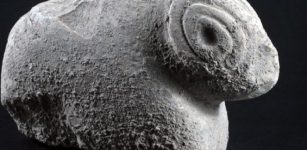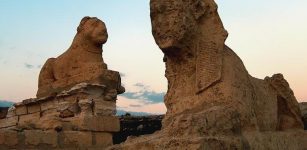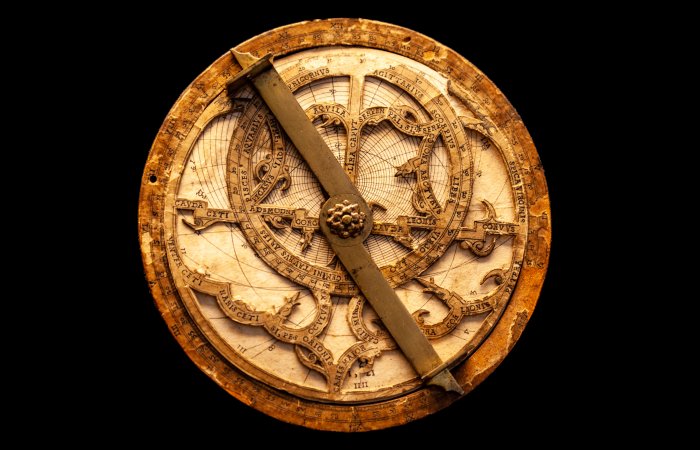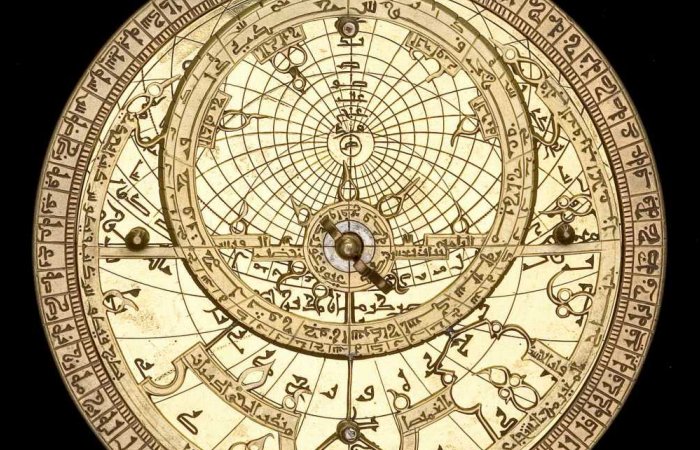Astrolabe: A Beautiful, Mysterious And Sophisticated Computer Of The Ancient World
A. Sutherland - AncientPages.com - The astrolabe is a beautiful ancient object. It is fair to say it is an instrument with a past and future. It is also a sophisticated ancient astronomical computer especially created for solving problems related to time and the position of the Sun and stars in the sky.
Credit: Adobe Stock - markrhiggins
In most cases, the astrolabes were made of brass and had a 6-inch diameter. Some of the objects were much larger.
The oldest astrolabes date back to two thousand years ago. Among the most popular types is the planispheric astrolabe, on which the celestial sphere is projected onto the plane of the equator. Despite being created at a time when people thought that the Earth was the center of the universe, the astrolabe is a useful ancient tool.
The object operates on the same basis as any other modern computer. You provide it with data, that is, input information, and then you receive output.
Ancient people used astrolabes to find out how the sky looked at a specific place at a given time. It was done by drawing the sky on the face of the astrolabe and marking it, so positions in the sky were easy to find.
An 18th Century Persian astrolabe–maker unknown. The points of the curved spikes on the front rete plate, mark the positions of the brightest stars. The name of each star being labeled at the base of each spike. The backplate or mater is engraved with projected coordinate lines. From the Whipple Museum of the History of Science in Cambridge. Image credit: Andrew Dunn - CC BY-SA 2.0
To use an astrolabe, you adjust the moveable components to a specific date and time. Once set, much of the sky, both visible and invisible, is represented on the face of the instrument.
This clever ancient computer was mainly used to find the time during the day or night, the time of a celestial event such as sunrise or sunset, and as a reference for stellar positions.
During the late Middle Ages, it served as a primary education astronomy tool and was sometimes even used for astrological purposes.
The typical astrolabe was not a navigational instrument. However, the mariner's astrolabe was widely used in the Renaissance. The device can measure the altitude above the horizon of a celestial body, day or night, identify stars and planets, determine local latitude on land or calm seas, and survey.
Astrolabe made between 1081 and 1082. Credit: History of Science Museum - CC BY-SA 4.0
The astrolabe was important in classical antiquity, the Islamic Golden Age, and the European Middle Ages. The name 'astrolabium' refers to the so-called prismatic astrolabe, invented by the French astronomer André Danjon.
The early astrolabe was invented in the Hellenistic civilization by Apollonius of Perga between 220 and 150 BC, often attributed to Hipparchus, a Greek mathematician, geographer, and astronomer who lived in the 2nd century BC. The essential part of the astrolabe is a brass plate with the lines of the celestial body's height above the horizon. It also has azimuth lines, and the hour wheels were engraved. Through the center of the plate was a line marking the north pole of the sky.
Hypatia (c. 350–370; died 415 AD), a great ancient scholar, built many astrolabes, but she did not invent them. The astrolabe was already in use at least 500 years before Hypatia was born.
Today, the astrolabe is still admired for its beauty and appreciated for its unique capabilities and its value for astronomy education.
Written by – A. Sutherland - AncientPages.com Senior Staff Writer
Updated on March 4, 2024
Copyright © AncientPages.com All rights reserved. This material may not be published, broadcast, rewritten or redistributed in whole or part without the express written permission of AncientPages.com
Expand for referencesMore From Ancient Pages
-
 Ancient Papyrus Of Merer Reveals How The Great Pyramid Of Giza Was Built
Archaeology | Sep 27, 2017
Ancient Papyrus Of Merer Reveals How The Great Pyramid Of Giza Was Built
Archaeology | Sep 27, 2017 -
 Vindolanda Treasures: Rare Roman Cornu Mouthpiece – Instrument of War – Uncovered
Archaeology | Sep 24, 2022
Vindolanda Treasures: Rare Roman Cornu Mouthpiece – Instrument of War – Uncovered
Archaeology | Sep 24, 2022 -
 Two Stone Age 9,500-Year-Old Artifacts Unearthed In Tel Motza
Archaeology | Sep 3, 2012
Two Stone Age 9,500-Year-Old Artifacts Unearthed In Tel Motza
Archaeology | Sep 3, 2012 -
 Viking Age Mass Grave Reveals Gruesome Discovery At Historical Village Of Repton, England
Archaeology | Feb 4, 2018
Viking Age Mass Grave Reveals Gruesome Discovery At Historical Village Of Repton, England
Archaeology | Feb 4, 2018 -
 Thriving Faiyum Oasis Declined And Was Abandoned Due To Climate Change
Archaeology | Jan 26, 2021
Thriving Faiyum Oasis Declined And Was Abandoned Due To Climate Change
Archaeology | Jan 26, 2021 -
 1.5-Million-Year-Old Hominin Fossil Reveals Missing Link In Human Evolution
Archaeology | Mar 16, 2022
1.5-Million-Year-Old Hominin Fossil Reveals Missing Link In Human Evolution
Archaeology | Mar 16, 2022 -
 Mysterious Ancient Shapeshifters Who Guided Humans And The Battle Of The Gods Described In Sacred Texts And Myths
Featured Stories | Oct 27, 2021
Mysterious Ancient Shapeshifters Who Guided Humans And The Battle Of The Gods Described In Sacred Texts And Myths
Featured Stories | Oct 27, 2021 -
 On This Day In History: Edict Of Milan Is Signed – Persecution Of Christians Ends – June 13, 313 AD
News | Jun 13, 2016
On This Day In History: Edict Of Milan Is Signed – Persecution Of Christians Ends – June 13, 313 AD
News | Jun 13, 2016 -
 More Anglo-Saxon Burials And Artifacts Found In Lincolnshire, UK
Archaeology | Jan 11, 2024
More Anglo-Saxon Burials And Artifacts Found In Lincolnshire, UK
Archaeology | Jan 11, 2024 -
 New Clues Why Neanderthals Visited La Cotte de St Brelade In Jersey 250,000 Years Ago
Archaeology | Jun 18, 2023
New Clues Why Neanderthals Visited La Cotte de St Brelade In Jersey 250,000 Years Ago
Archaeology | Jun 18, 2023 -
 Brahma: First God In Hindu Trimurti, Creator Of The World And All Creatures
Featured Stories | Apr 17, 2019
Brahma: First God In Hindu Trimurti, Creator Of The World And All Creatures
Featured Stories | Apr 17, 2019 -
 Ancient Script Reveals Mysterious Location Of Legendary Hanging Garden Of Babylon
Featured Stories | Apr 4, 2014
Ancient Script Reveals Mysterious Location Of Legendary Hanging Garden Of Babylon
Featured Stories | Apr 4, 2014 -
 Ancient Roman Sandal With Nails And Game Pieces Found Under A Playground In Germany
Archaeology | Nov 22, 2024
Ancient Roman Sandal With Nails And Game Pieces Found Under A Playground In Germany
Archaeology | Nov 22, 2024 -
 Mysterious Depiction Of Pharaoh Hatshepsut
Archaeology | May 17, 2018
Mysterious Depiction Of Pharaoh Hatshepsut
Archaeology | May 17, 2018 -
 3,500-Year-Old Egyptian Tomb Of Guardian Of Pharaoh’s Secret Archive Discovered In Saqqara
Archaeology | May 7, 2022
3,500-Year-Old Egyptian Tomb Of Guardian Of Pharaoh’s Secret Archive Discovered In Saqqara
Archaeology | May 7, 2022 -
 Riddle Of The Hanging Gardens Of Babylon – Ancient Place Still Shrouded In Mystery – Part 1
Featured Stories | Jun 7, 2019
Riddle Of The Hanging Gardens Of Babylon – Ancient Place Still Shrouded In Mystery – Part 1
Featured Stories | Jun 7, 2019 -
 Mayong – Mysterious Ancient Land Of Black Magic In India
Featured Stories | Mar 7, 2019
Mayong – Mysterious Ancient Land Of Black Magic In India
Featured Stories | Mar 7, 2019 -
 ChatGPT Is Confronting, But Humans Have Always Adapted To New Technology – Ask The Mesopotamians, Who Invented Writing
Featured Stories | Feb 13, 2023
ChatGPT Is Confronting, But Humans Have Always Adapted To New Technology – Ask The Mesopotamians, Who Invented Writing
Featured Stories | Feb 13, 2023 -
 Underground Hellenistic Necropolis With Tombs With Frescoes, Reliefs Unearthed In Naples, Italy
Archaeology | May 13, 2023
Underground Hellenistic Necropolis With Tombs With Frescoes, Reliefs Unearthed In Naples, Italy
Archaeology | May 13, 2023 -
 Why Was The Medieval Town Of Wagrain Suddenly Abandoned 1,300 Years Ago?
Archaeology | Oct 7, 2024
Why Was The Medieval Town Of Wagrain Suddenly Abandoned 1,300 Years Ago?
Archaeology | Oct 7, 2024



